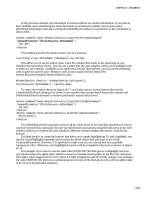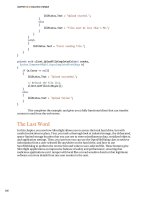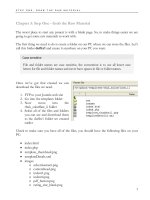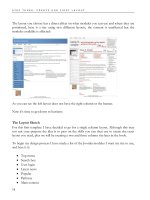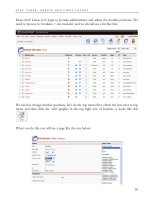A Laboratory Course in C++Data Structures phần 10 potx
Bạn đang xem bản rút gọn của tài liệu. Xem và tải ngay bản đầy đủ của tài liệu tại đây (508.5 KB, 43 trang )
370
|
Laboratory B
Test Plan for the heapSort Operation
Test Case
Array
Expected Result
Checked
Heap ADT
|
371
Laboratory B: In-lab Exercise 3
Name __________________________________________ Date _______________________
Section _________________________________________
Examining the tree form of a heap rotated 90 degrees counterclockwise from its conventional
orientation can be awkward. Because a heap is a complete tree, an unambiguous representation in
tree form can be generated by outputting the heap level by level, with each level output on a
separate line.
void writeLevels () const
Requirements:
None
Results:
Outputs the data items in a heap in level order, one level per line. Only outputs each data item’s
priority. If the heap is empty, then outputs “Empty heap”.
The tree shown on the first page of this laboratory, for example, yields the following output.
93
82 64
27 75 39 18
Step 1: Implement this operation and add it to the file heap.cpp. A prototype for this operation is
included in the declaration of the Heap class in the file heap.h.
Step 2: Activate the 'W' (write levels) command in the test program in the file testb.cpp by
removing the comment delimiter (and the character 'W') from the lines that begin with
"//W".
Step 3: Prepare a test plan for this operation that covers heaps of various sizes, including empty
and single-data item heaps. A test plan form follows.
Step 4: Execute your test plan. If you discover mistakes in your implementation of the
writeLevels operation, correct them and execute your test plan again.
372
|
Laboratory B
Test Plan for the writeLevels Operation
Test Case
Commands
Expected Result
Checked
Heap ADT
|
373
Laboratory B: Postlab Exercise 1
Name __________________________________________ Date _______________________
Section _________________________________________
You can use a heap—or a priority queue (In-lab Exercise 1)—to implement both a first-in, first-out
(FIFO) queue and a stack. The trick is to use the order in which data items arrive as the basis for
determining the data items’ priority values.
Part A
How would you assign priority values to data items to produce a FIFO queue?
374
|
Laboratory B
Part B
How would you assign priority values to data items to produce a stack?
Heap ADT
|
375
Laboratory B: Postlab Exercise 2
Name __________________________________________ Date _______________________
Section _________________________________________
Part A
Given a heap containing 10 data items with distinct priorities, where in the heap can the data item
with the next-to-highest priority be located? Give examples to illustrate your answer.
376
|
Laboratory B
Part B
Given the same heap as in Part A, where in the heap can the data item with the lowest priority be
located? Give examples to illustrate your answer.
Performance Evaluation
Implement a Timer class that you can use to measure
the length time between two events—when a function
starts and when it finishes, for instance
Compare the performance of a set of searching
routines
Compare the performance of a set of sorting routines
Compare the performance of your array and linked list
implementations of the Stack ADT
Objectives
In this laboratory you will:
378
|
Laboratory C
Overview
A routine’s performance can be judged in many ways and on many levels. In other
laboratories, you describe performance using order-of-magnitude estimates of a
routine’s execution time. You develop these estimates by analyzing how the routine
performs its task, paying particular attention to how it uses iteration and recursion.
You then express the routine’s projected execution time as a function of the number of
data items (N) that it manipulates as it performs its task. The results are estimates of
the form O(N), O(LogN), and so on.
These order-of-magnitude estimates allow you to group routines based on their
projected performance under different conditions (best case, worst case, and so forth).
As important as these order-of-magnitude estimates are, they are by their very nature
only estimates. They do not take into account factors specific to a particular
environment, such as how a routine is implemented, the type of computer system on
which it is being run, and the kind of data being processed. If you are to accurately
determine how well or poorly a given routine will perform in a particular environment,
you need to evaluate the routine in that environment.
In this laboratory, you measure the performance of a variety of routines. You
begin by developing a set of tools that allow you to measure execution time. Then you
use these tools to measure the execution times of the routines.
You can determine a routine’s execution time in a number of ways. The timings
performed in this laboratory will be generated using the approach summarized below.
Get the current system time (call this startTime).
Execute the routine.
Get the current system time (call this stopTime).
The routine’s execution time = startTime Ϫ stopTime.
If the routine executes very rapidly, then the difference between startTime and
stopTime may be too small for your computer system to measure. Should this be the
case, you need to execute the routine several times and divide the length of the
resulting time interval by the number of repetitions, as follows:
Get the current system time (call this startTime).
Execute the routine m times.
Get the current system time (call this stopTime).
The routine’s execution time = ( startTime Ϫ stopTime ) / m.
To use this approach, you must have some method for getting and storing the
“current system time”. How the current system time is defined and how it is accessed
varies from system to system. Two common methods are outlined below.
Method 1
Use a function call to get the amount of processor time that your program (or process)
has used. Typically, the processor time is measured in clock ticks or fractions of a
second. Store this information in a variable of the following type:
typedef long SystemTime;
Performance Evaluation
You can use this method on most systems. You must use it on multiuser or
multiprocess systems, where the routine you are timing is not the only program
running.
Method 2
Use a function call to get the current time of day. Store this information in a variable
of the following type:
struct SystemTime
{
int hour,
minute,
second,
fraction;
};
//
//
//
//
Hour
0-23
Minute 0-59
Second 0-59
Fraction of a second
The range of values for the fraction field depends on the resolution of the system
clock. Common ranges are 0–99 (hundredths of a second) and 0–999 (thousandths of a
second). This method is effective only on single-user/single-process systems where the
routine you are timing is the only program running.
In addition to acquiring and storing a point in time, you also need a convenient
mechanism for measuring time intervals. The Timer ADT described below uses the
familiar stopwatch metaphor to describe the timing process.
Start the timer.
...
Stop the timer.
Read the elapsed time.
Timer ADT
Data Items
A pair of times that denote the beginning and end of a time interval.
Structure
None
Operations
void start ()
Requirements
None
Results
Marks the beginning of a time interval (starts the timer).
|
379
380
|
Laboratory C
void stop ()
Requirements
The beginning of a time interval has been marked.
Results
Marks the end of a time interval (stops the timer).
double getElapsedTime ()
Requirements
The beginning and end of a time interval have been marked.
Results
Returns the length of the time interval in seconds.
Performance Evaluation
|
381
Laboratory C: Cover Sheet
Name __________________________________________ Date _______________________
Section _________________________________________
Place a check mark in the Assigned column next to the exercises your instructor has assigned to
you. Attach this cover sheet to the front of the packet of materials you submit following the
laboratory.
Activities
Prelab Exercise
Bridge Exercise
In-lab Exercise 1
In-lab Exercise 2
In-lab Exercise 3
Postlab Exercise 1
Postlab Exercise 2
Total
Assigned: Check or
list exercise numbers
Completed
Performance Evaluation
|
383
Laboratory C: Prelab Exercise
Name __________________________________________ Date _______________________
Section _________________________________________
Step 1: Select one of the two methods for acquiring and representing a point in time and use this
method to create an implementation of the Timer ADT. Base your implementation on the
following class declaration from the file timer.hs.
// Insert a declaration for SystemTime here.
class Timer
{
public:
// Start and stop the timer
void start ();
void stop ();
// Compute the elapsed time (in seconds)
double getElapsedTime ();
private:
SystemTime startTime,
stopTime;
// Time that the timer was started
// Time that the timer was stopped
};
Step 2: Add the appropriate declaration for SystemTime to the beginning of the file and save the
resulting header file as timer.h. Save your implementation of the Timer ADT in the file
time.cpp.
Step 3: What is the resolution of your implementation—that is, what is the shortest time interval
it can accurately measure?
384
|
Laboratory C
Laboratory C: Bridge Exercise
Name __________________________________________ Date _______________________
Section _________________________________________
Check with your instructor whether you are to complete this exercise prior to your lab period
or during lab.
The test program in the program shell file testc.cs allows you to test the accuracy of your
implementation of the Timer ADT by measuring time intervals of known duration.
#include <iostream>
#include <iomanip>
#include <ctime>
#include “timer.h”
using namespace std;
// wait() is cross platform and works well but is not efficient.
// Feel free to replace it with a routine that works better in
// your environment.
void wait(int secs)
{
int start = clock();
while (clock() - start < CLOCKS_PER_SEC * secs);
}
void main()
{
Timer checkTimer;
clock_t timeInterval;
// Timer
// Time interval to pause
// Get the time interval.
// Measure the specified time interval.
checkTimer.start();
checkTimer.stop();
// Start the timer
// Pause for the specified time interval
// Stop the timer
cout << “Measured time interval ( in seconds ) : ”
<< checkTimer.getElapsedTime() << endl;
}
Step 1: Two data items are left incomplete in this program: the call to the function that pauses
the program and the string that prompts the user to enter a time interval. Complete the
program by specifying the name of a “pause” function supported by your system.
Common names for this function include sleep(), delay(), and pause(). Or you can
use the provided wait() function. Add the time unit used by this function to the prompt
string. Save the resulting program as testc.cpp.
Performance Evaluation
Step 2: Prepare a test plan for your implementation of the Timer ADT. Your test plan
should cover intervals of various lengths, including intervals at or near the
resolution of your implementation. A test plan form follows.
Step 3: Execute your test plan. If you discover mistakes in your implementation,
correct them and execute your test plan again.
Test Plan for the Operations in the Timer ADT
Test Case
Actual Time Period
(in seconds)
Measured time period
(in seconds)
Checked
|
385
386
|
Laboratory C
Laboratory C: In-lab Exercise 1
Name __________________________________________ Date _______________________
Section _________________________________________
In this exercise you will examine the performance of the searching routines in the file search.cpp.
Step 1: Use the program in the file timesrch.cpp to measure the execution times of the
linearSearch(), binarySearch(), and unknownSearch() routines. This program
begins by generating an ordered list of integer keys (keyList) and a set of keys to search
for in this list (searchSet). It then measures the amount of time it takes to search for the
keys using the specified routines and computes the average time per search.
The constant numRepetitions controls how many times each search is executed.
Depending on the speed of your system, you may need to use a value of
numRepetitions that differs from the value given in the test program. Before
continuing, check with your instructor regarding what value of numRepetitions you
should use.
Step 2: Complete the following table by measuring the execution times of the linearSearch(),
binarySearch(), and unknownSearch() routines for each of the values of numKeys
listed in the table.
Execution Times of a Set of Searching Routines
Routine
Number of keys in the list (numKeys)
1000
linearSearch()
O(N)
binarySearch()
O(LogN)
unknownSearch() O(
)
2000
4000
Performance Evaluation
Search time (seconds)
Step 3: Plot your results below.
1000
2000
3000
4000
Number of keys in the list (numKeys)
Step 4: How well do your measured times conform with the order-of-magnitude
estimates given for the linearSearch() and binarySearch() routines?
Step 5: Using the code in the file search.cpp and your measured execution times as a
basis, develop an order-of-magnitude estimate of the execution time of the
unknownSearch() routine. Briefly explain your reasoning behind this
estimate.
|
387
388
|
Laboratory C
Laboratory C: In-lab Exercise 2
Name __________________________________________ Date _______________________
Section _________________________________________
In this exercise you will examine the performance of the set of sorting routines in the file sort.cpp.
Step 1: Use the program in the file timesort.cpp to measure the execution times of the
selectionSort(), quickSort(), and unknownSort() routines. This program begins
by generating a list of integer keys (keyList). It then measures the amount of time it
takes to sort this list into ascending order using the specified routine.
The constant numRepetitions controls how many times each search is executed.
Depending on the speed of your system, you may need to use a value of
numRepetitions that differs from the value given in the test program. Before
continuing, check with your instructor regarding what value of numRepetitions you
should use.
Step 2: Complete the following table by measuring the execution times of the
selectionSort(), quickSort(), and unknownSort() routines for each combination
of the three test categories and the three values of numKeys listed in the table.
Execution Times of a Set of Sorting Routines
Routine
Number of keys in the list (numKeys)
1000
selectionSort() O(N )
2
quickSort()
unknownSort()
O(NLogN)
O(
)
2000
4000
Performance Evaluation
Sort time (seconds)
Step 3: Plot your results below.
1000
2000
3000
4000
Number of keys in the list (numKeys)
Step 4: How well do your measured times conform with the order-of-magnitude
estimates given for the selectionSort() and quickSort() routines?
Step 5: Using the code in the file sort.cpp and your measured execution times as a
basis, develop an order-of-magnitude estimate of the execution time of the
unknownSort() routine. Briefly explain your reasoning behind this estimate.
|
389
390
|
Laboratory C
Laboratory C: In-lab Exercise 3
Name __________________________________________ Date _______________________
Section _________________________________________
In this exercise you will measure the performance of the array and linked list implementations of
the Stack ADT that you created in Laboratory 5.
Step 1: Using the implementation of the Timer ADT that you created in the Prelab as a
foundation, write a program that measures the time it takes to completely fill and then
empty a 1000-data item stack using the push and pop operations in Stack ADT. Because
these operations execute so rapidly, you may need to fill and empty the stack a number
of times in order to produce an accurate measurement of the time it takes to complete a
fill/empty cycle.
Step 2: Use your program to measure the time it takes each of your Stack ADT implementations
to fill and empty a stack containing 1000 characters and record the results in the
following table.
Step 3: Repeat these measurements using a stack containing 1000 long integers and record the
results below.
Time to Fill and Empty a 1000-Data Item Stack
Stack ADT implementation
Stack data item
char
Array implementation
Linked list implementation
long int
Performance Evaluation
|
391
Laboratory C: Postlab Exercise 1
Name __________________________________________ Date _______________________
Section _________________________________________
You are given another pair of searching routines. Both routines have order-of-magnitude
execution time estimates of O(N). When you measure the actual execution times of these routines
on a given system using a variety of different data sets, you discover that one routine consistently
executes five times faster than the other. How can both routines be O(N), yet have different
execution times when they are compared using the same system and the same data?
Performance Evaluation
|
393
Laboratory C: Postlab Exercise 2
Name __________________________________________ Date _______________________
Section _________________________________________
Using your measurements from In-lab Exercises 1 and 2 as a basis, estimate the execution times of
the routines listed below for a randomly generated list of 8000 integer keys. Do not measure the
actual execution times of these routines using a list of this size. Estimate what their execution
times will be based on the measurements you have already done. Briefly explain your reasoning
behind each estimate.
linearSearch()
Estimated execution time:
Explanation:
binarySearch()
Explanation:
Estimated execution time:
394
|
Laboratory C
selectionSort()
Estimated execution time:
Explanation:
quickSort()
Explanation:
Estimated execution time:



